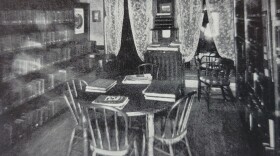During World War II, the war effort stretched far beyond the battlefields and into the very heart of small towns across America. Here in Rhinelander, our own paper mill, the Rhinelander Paper Company, quietly played a vital role in getting our troops the tools they needed to fight and win.
The mill had been a fixture in Rhinelander since the early 1900s, but in 1916 it took a bold step into specialty paper production, installing its first glassine machine. Glassine is a smooth, translucent, grease-resistant paper made by pressing highly beaten pulp into a dense, moisture-resistant sheet. By the 1930s, Rhinelander had become one of the world’s top producers of glassine papers, and during the war years, half of all the glassine made in the United States came from the Rhinelander paper mill.
So proud was the company of its specialty that the word “GLASSINE” was emblazoned high on one of its two red brick smokestacks, landmarks greeting workers, townsfolk, and visitors alike. Those stacks stood for decades, until later years when they were shortened for safety, and much of the proud lettering disappeared into history.
During WWII, glassine paper was in higher demand than ever. The U.S. Army needed specialty papers for its maps and overlays. In the days before GPS, those maps were the lifeline of every operation, and overlays, semi-transparent sheets placed over the maps, allowed officers to mark troop positions, plan attacks, and track movement without damaging the originals.
Glassine was perfect for the job: it took pencil or ink cleanly, resisted moisture and oil, and could survive the rugged conditions of a soldier’s field pack. The Army used it not only for overlays but also to wrap and protect maps bound for every theater of war. While the soldiers saw only the finished product, much of that material likely started its journey right here in Rhinelander, rolled off the giant machines in the mill and packed for shipment to military mapmakers across the country.
As the Rhinelander Daily News later recalled in the company’s 50th anniversary write-up, these “special high-quality translucent grades of greaseproof known as ‘tracing papers’” were “widely used for both military and industrial drawing purposes.”
Like many Northwoods industries of the era, Rhinelander Paper Company shifted part of its production to meet wartime needs, shipping out reams of this specialty “map paper” without fanfare or headlines. There was no parade in town square, but the quiet contribution of our paper workers made a real difference in the outcome of the war.
It’s one more example of how, in the Northwoods, even the hum of a paper machine could be part of the fight to win a world war.
I’m Kerry Bloedorn and this is A Northwoods Moment in History on WXPR
Source: Rhinelander Paper Company archive, Rhinelander Daily News.
Photo: Rhinelander Paper Mill at night circa 1940.









